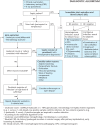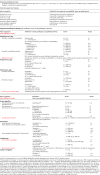Periprosthetic joint infection: current concepts and outlook
- PMID: 31423332
- PMCID: PMC6667982
- DOI: 10.1302/2058-5241.4.180092
Periprosthetic joint infection: current concepts and outlook
Abstract
Periprosthetic joint infection (PJI) is a serious complication occurring in 1% to 2% of primary arthroplasties, which is associated with high morbidity and need for complex interdisciplinary treatment strategies.The challenge in the management of PJI is the persistence of micro-organisms on the implant surface in the form of biofilm. Understanding this ability, the phases of biofilm formation, antimicrobial susceptibility and the limitations of host local immune response allows an individual choice of the most suitable treatment.By using diagnostic methods for biofilm detection such as sonication, the sensitivity for diagnosing PJI is increasing, especially in chronic infections caused by low-virulence pathogens.The use of biofilm-active antibiotics enables eradication of micro-organisms in the presence of a foreign body. The total duration of antibiotic treatment following revision surgery should not exceed 12 weeks. Cite this article: EFORT Open Rev 2019;4:482-494. DOI: 10.1302/2058-5241.4.180092.
Keywords: arthroplasty; biofilm; diagnosis; periprosthetic joint infection; treatment.
Conflict of interest statement
ICMJE Conflict of interest statement: OB reports board membership as the incoming president of Swiss Orthopaedics, consultancy for Medacta, Heraeus, Stryker and Orthofix, receiving grants or grants pending from Orthofix, Lima, Medacta and Matthys, payment for lectures including service on speakers bureaus from Lima, Medacta, Orthofix and Stryker, all outside the published work. AT reports board membership of and a research grant from Heraeus Medical, grants or grants pending from Zimmer Biomet, payment for lectures including service on speakers bureaus from InfectoPharm and providing educational material to PRO-IMPLANT Foundation, all outside the published work.
Figures







References
-
- Corvec S, Portillo ME, Pasticci BM, Borens O, Trampuz A. Epidemiology and new developments in the diagnosis of prosthetic joint infection. Int J Artif Organs 2012;35:923–934. - PubMed
-
- Kurtz S, Ong K, Lau E, Mowat F, Halpern M. Projections of primary and revision hip and knee arthroplasty in the United States from 2005 to 2030. J Bone Joint Surg Am 2007;89:780–785. - PubMed
-
- Zimmerli W, Trampuz A, Ochsner PE. Prosthetic-joint infections. N Engl J Med 2004;351:1645–1654. - PubMed
-
- Ong KL, Kurtz SM, Lau E, Bozic KJ, Berry DJ, Parvizi J. Prosthetic joint infection risk after total hip arthroplasty in the Medicare population. J Arthroplasty 2009;24:105–109. - PubMed
-
- Karczewski D, Winkler T, Renz N, Trampuz A, Lieb E, Perka C, Müller M. A standardized interdisciplinary algorithm for the treatment of prosthetic joint infections. Bone Joint J 2019;101-B(2):132–139. - PubMed
Publication types
LinkOut - more resources
Full Text Sources

